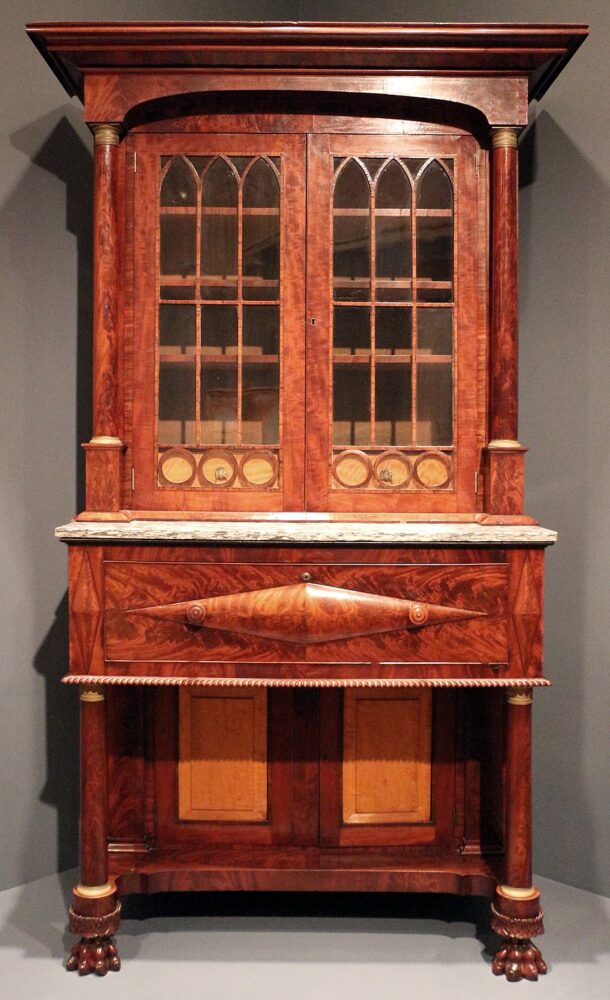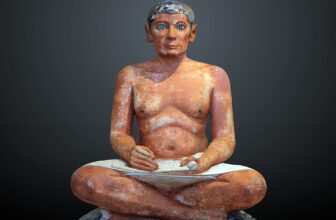
| Shopping Ads: Invest in Hidden Masterpiece: Rare Antique Oil Paintings For Sale. Limited Originals Available 💰😊 Are you looking for authentic hidden masterpiece? Explore old master antique oil paintings from the Renaissance and Baroque eras. From 16th-century portraits to 18th-century landscapes. Authenticity guaranteed, Old Master antique oil paintings for sale. Shop Now! 🎨 Renaissance And Baroque Art Landscape Antique Paintings Old Master Portrait Paintings |
The Majesty of Empire Style furniture
In the grand salons of 19th-century France, where polished mahogany gleamed under candlelight and gilded eagles perched atop chair backs, a new aesthetic was born. Known as Empire style, this regal approach to furniture and design rose to prominence during the rule of Napoleon Bonaparte, who, in his ambition to revive the glory of ancient Rome and project the power of his reign, became an unlikely but profound influencer of interior decoration.
But what exactly is Empire style furniture? What defines it, and what does it look like? How did it reflect Napoleon’s political ideologies and artistic tastes? In this journey, we’ll delve into the origins, key characteristics, and enduring legacy of this majestic style that turned the furniture of a nation into a statement of imperial authority.
What is Empire Style Furniture?
Empire style furniture is a distinctive and opulent form of design that originated in early 19th-century France, during the reign of Napoleon I (1804–1815). It is part of the broader Neoclassical movement but is specifically aligned with the First French Empire. The term “Empire” refers directly to the political regime Napoleon established and, symbolically, to the empire of ancient Rome, a civilization that heavily influenced the style’s themes and motifs.
This furniture style was not just about comfort or aesthetics, it was deeply political and symbolic. It served as a visual propaganda tool, embodying the strength, order, and authority of the French Empire. From thrones and dressers to canopy beds and writing desks, every piece echoed the grandeur of classical antiquity, carefully curated to assert power.
What Defines Empire Style?
Empire style is defined by a combination of classical influences, strong geometric shapes, and rich materials. It draws heavily from ancient Roman, Greek, and Egyptian motifs. Napoleon’s military campaigns, especially his Egyptian expedition, directly contributed to these influences.
Here are the defining characteristics of Empire style:
-
Classical Motifs: These include columns, laurel wreaths, acanthus leaves, sphinxes, and mythological creatures. The eagle, a symbol of Roman legions and Napoleon himself, appears frequently.
-
Symmetry and Monumentality: Empire furniture features symmetrical compositions and massive proportions. Pieces often appear grand, with straight lines and architectural elements like pilasters and pediments.
-
Rich Materials: Mahogany was the wood of choice, appreciated for its rich color and fine grain. Furniture was often adorned with gilded bronze (ormolu) mounts and accents.
-
Color Palette: Deep reds, blacks, golds, and imperial blues dominate, reflecting both luxury and military prestige.
-
Craftsmanship: The style places heavy emphasis on exceptional workmanship. French cabinetmakers like François-Honoré-Georges Jacob-Desmalter became famous for their Empire creations.
-
Emblems of Power: Bees (representing Napoleon’s dynasty), crowns, lyres, and torches appear often as decorative motifs.
The Empire style wasn’t confined to furniture, it extended to architecture, clothing, textiles, and decorative arts, shaping an entire cultural movement.
What Was Napoleon’s Art Style?
Napoleon’s preferred art style was Neoclassicism, of which Empire style is a specific, glorified expression. While the Rococo period that preceded him was characterized by whimsy and lightness, Napoleon favored order, rationality, and martial grandeur, traits that aligned with his persona and military ambitions.
Napoleon strategically used art and design to legitimize his rule. His regime sponsored grand historical paintings, colossal sculptures, and decorative arts that aligned him with Roman emperors. Artists like Jacques-Louis David became central to this visual propaganda. David’s iconic painting The Coronation of Napoleon encapsulates the grandeur and self-fashioned mythology of the Emperor.
In furniture and interior design, Napoleon’s style translated into a visual vocabulary that was masculine, assertive, and imperial. Where Louis XVI’s Neoclassicism was refined and elegant, Napoleon’s Empire was bold and commanding.
What Does Empire Style Look Like?
Empire style is visually striking and unmistakable. A single glance at a classic Empire room and you’re immediately enveloped by its stately atmosphere. Here’s a vivid description of what Empire style furniture and decor typically look like:
-
Chairs: High-backed with curved arms, often featuring carved eagles or lion’s paws on the feet. Upholstery is rich, velvets or leathers in deep, saturated colors.
-
Tables: Round or rectangular with strong, columnar legs. Inlays of brass and gold ormolu accents decorate the surfaces.
-
Beds: Often “lit en bateau” (boat-shaped), with scrolled ends and bold carvings. Beds were typically made of dark mahogany and decorated with gilded motifs.
-
Dressers & Commodes: Featuring wide drawers, massive proportions, and adorned with mounts of gilded bronze. Sometimes topped with black marble.
-
Decorative Elements: Mirrors with gilt frames, busts of Roman emperors, tapestries featuring military scenes, and chandeliers dripping with crystal and bronze.
The rooms were arranged symmetrically, reinforcing the style’s classical inspiration. Large, open spaces were preferred to emphasize the grandeur and scale of the furnishings.
What is an Empire Style Dresser?
An Empire style dresser, also referred to as a commode, is one of the most iconic pieces of this style. It typically features the following:
-
Heavy, Rectilinear Form: Empire dressers are robust and symmetrical, often square or rectangular.
-
Mahogany Construction: The dark, reddish-brown wood lends it a stately elegance.
-
Ormolu Decoration: Gilded bronze mounts in the shape of swans, lion heads, rosettes, or classical scrolls enhance the structure.
-
Column Detailing: Half-columns or pilasters are frequently used at the corners, capped with bronze capitals and bases.
-
Marble Tops: Many Empire dressers have black or gray marble tops, adding to their luxurious presence.
These dressers were not just functional, they were statements of taste and authority. Positioned in entry halls, bedrooms, or salons, they conveyed the owner’s alignment with imperial ideals.
When Was Empire Style Popular?
The Empire style was most popular from approximately 1800 to 1830. It began during the Consulate period (1799–1804), flourished during Napoleon’s reign as Emperor (1804–1815), and extended into the Restoration period (1815–1830) under Louis XVIII and Charles X, though gradually blending into other styles.
Its spread wasn’t limited to France. The style found international followers:
-
Russia: Under Tsar Alexander I, Russian aristocrats embraced Empire design, adapting it with local elements.
-
Italy & Germany: Given Napoleon’s influence over much of Europe, Empire style became a dominant aesthetic in many courts and city-states.
-
United States: In the U.S., the Empire style merged with earlier Federal styles to form the American Empire style, particularly popular from 1820–1840.
What is the Early Empire Style?
The Early Empire style refers to the transitional phase from the Louis XVI style to the more robust and martial look of high Empire. This period, roughly 1800 to 1805, still retained many of the elegant proportions and refined detailing of the late 18th century, but began to incorporate more classical and military elements.
Features of Early Empire include:
-
Subtler Ornamentation: While still using bronze and classical motifs, early Empire furniture had less flamboyant decoration than what followed.
-
Lighter Forms: Furniture was more delicate than the later, massive pieces typical of the mature Empire phase.
-
Closer Ties to the Directory and Consulate Styles: These earlier transitional styles acted as a bridge from Rococo lightness to Empire gravity.
Early Empire is often considered by collectors and historians as particularly desirable for its balance between elegance and authority.
Legacy and Influence
Although Empire style faded from fashion by the mid-19th century, its impact has been long-lasting:
-
Revival Styles: There were periodic revivals in the 19th and 20th centuries, particularly during periods of nationalism and militarism.
-
Hollywood Regency and Art Deco: These 20th-century styles borrowed heavily from Empire’s drama and classical themes, albeit with modern materials and forms.
-
Modern Collectors: Authentic Empire pieces are highly valued in the antique world. Their craftsmanship, historical significance, and artistic merit make them prized by collectors, interior designers, and museums.
Moreover, Empire’s influence persists in the grandeur of state buildings, military uniforms, and neoclassical architecture around the world. From the U.S. Capitol to the décor of royal palaces, echoes of Empire style endure.
Empire style furniture is far more than an aesthetic, it’s a manifestation of power, ideology, and artistic vision. Borne from Napoleon’s desire to align his regime with the grandeur of antiquity, the style has come to symbolize a unique moment in European history when art, politics, and imperial ambition converged.
Defined by classical motifs, monumental forms, rich materials, and masterful craftsmanship, Empire furniture transformed everyday objects into instruments of statecraft. Whether you’re admiring a mahogany commode crowned with gilded eagles or sitting in a throne-like chair carved with laurels and sphinxes, you’re engaging with history, a history sculpted by emperors, artists, and artisans alike.
To embrace Empire style is to bring a touch of ancient Rome, Revolutionary France, and Napoleonic grandeur into your space. In doing so, you connect with a chapter of design history where furniture was more than functional, it was imperial.


